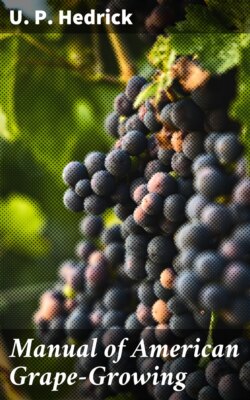Читать книгу Manual of American Grape-Growing - U. P. Hedrick - Страница 9
На сайте Литреса книга снята с продажи.
American Grapes
ОглавлениеFew other plants in the New World grow wild under such varied conditions and over such extended areas as the grape. Wild grapes are found in the warmer parts of New Brunswick; on the shores of the Great Lakes; everywhere in the woodlands of the North and Middle Atlantic states; on the limestone soils of Kentucky, Tennessee and the Virginias; and they thrive in the sandy woods, sea plains and reef-keys of the South Atlantic and Gulf states. While not so common west of the Mississippi, yet some kind of wild grape is found from North Dakota to Texas; grapes grow on the mountains and in the cañons of all the Rocky Mountain states; and several species thrive on the Mexican borders and in the far Southwest.
While it is possible that all American grapes have descended from an original species, the types are now as diverse as the regions they inhabit. The wild grapes of the forests have long slender trunks and branches, whereby their leaves are better exposed to the sunlight. Two shrubby species do not attain a greater height than four or five feet; these grow in sandy soils, or among rocks exposed to sun and air. Another runs on the ground and bears foliage almost evergreen. The stem of one species attains a diameter of a foot, bearing its foliage in a great canopy. From this giant form the species vary to slender, graceful, climbing vines. Wild grapes are as varied in climatic adaptations as in structure of vine and grow luxuriantly in every condition of heat or cold, wetness or dryness, capable of supporting fruit-culture in America. So many of the kinds have horticultural possibilities that it seems certain that some grape can be domesticated in all of the agricultural regions of the country, their natural plasticity indicating, even if it were not known from experience, that all can be domesticated.
Leif the Lucky, the first European to visit America, if the Icelandic records are true, christened the new land Wineland. It has been supposed that this designation was given for the grapes, but recent investigations show that the fruits were probably mountain cranberries. Captain John Hawkins, who visited the Spanish settlements in Florida in 1565, mentions wild grapes among the resources of the New World. Amadas and Barlowe, sent out by Raleigh in 1584, describe the coasts of the Carolinas as, "so full of grapes that in all the world like abundance cannot be found." Captain John Smith, writing in 1606, describes the grapes of Virginia and recommends the culture of the vine as an industry for the newly founded colony. Few, indeed, are the explorers of the Atlantic seaboard who do not mention grapes among the plants of the country. Yet none saw intrinsic value in these wild vines. To the Europeans, the grapes of the Old World alone were worth cultivating, and the vines growing everywhere in America only suggested that the grape they had known across the sea might be grown in the new home.
That American viticulture must depend on the native species for its varieties began to be recognized at the beginning of the nineteenth century, when several large companies engaged in growing foreign grapes failed, and a meritorious native grape made its appearance. The vine of promise was a variety known as the Alexander. Thomas Jefferson, ever alert for the agricultural welfare of the nation, writing in 1809 to John Adlum, one of the first experimenters with an American species, voiced the sentiment of grape experimenters in speaking of the Alexander: "I think it will be well to push the culture of this grape without losing time and efforts in the search of foreign vines, which it will take centuries to adapt to our soil and climate."
Fig. 2. A shoot of Vitis Labrusca.
Alexander is an offshoot of the common fox-grape, Vitis Labrusca (Fig. 2), found in the woods on the Atlantic coast from Maine to Georgia and occasionally in the Mississippi Valley. The history of the variety dates back to before the Revolutionary War, when, according to William Bartram, the Quaker botanist, it was found growing in the vicinity of Philadelphia, by John Alexander, gardener to Governor Penn of Pennsylvania. Curiously enough, it came into general cultivation through the deception of a nurseryman. Peter Legaux, a French-American grape-grower, in 1801 sold the Kentucky Vineyard Society fifteen hundred grape cuttings which he said had been taken from an European grape introduced from the Cape of Good Hope, therefore called the "Cape" grape. Legaux's grape turned out to be the Alexander. In the new home the spurious Cape grew wonderfully well and as the knowledge of its fruitfulness in Kentucky, Ohio and Indiana spread, demand for it increased, and with remarkable rapidity, considering the time, it came into general cultivation in the parts of the United States then settled.
